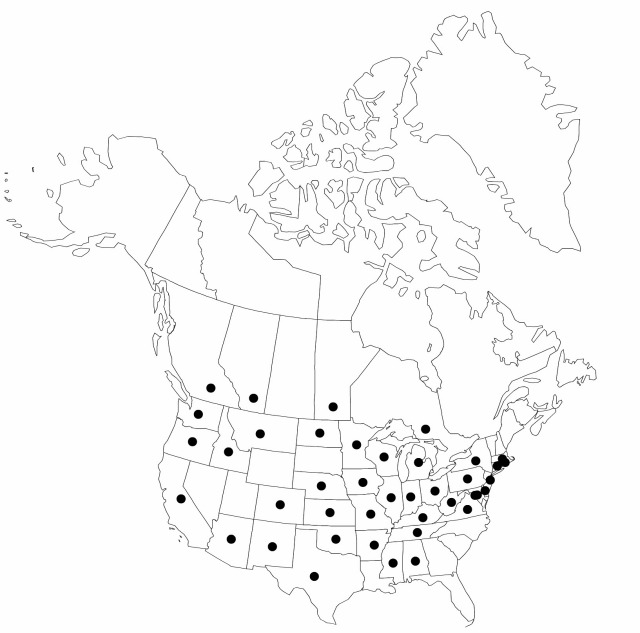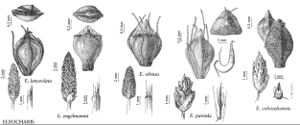Eleocharis engelmannii
Syn. Pl. Glumac. 2: 79. 1855.
Culms 2–40 cm × 0.5–1.5 (–2) mm. Leaves: apex of distal leaf-sheath obtuse to acute, tooth to 0.3 mm. Spikelets lanceoloid to subcylindric or ovoid, 5–10 (–20) × 2–3 (–4) mm, apex acute (to rounded); proximal scale empty, encircling ca. 2/3 of culm; floral scales 25–100 (–200), 8–12 per mm of rachilla, orangebrown to stramineous, 2 (–2.5) × 1–1.3 mm, midribs mostly keeled, ovate, apex narrowly rounded to subacute. Flowers: perianth bristles present or often absent, 5–8, brown, stout, rudimentary to slightly exceeding tubercle; stamens (2–) 3; anthers brown to yellow, 0.3–0.7 (–1) mm; styles 2–3-fid. Achenes 0.9–1.1 (–1.5) × 0.7–1.1 mm. Tubercles depressed, subdeltoid, 0.1–0.3 (–0.4) × 0.6–0.9 (–1) mm, 1/10–2/5 as high as wide, 1/4 or less as high as achene, 9/10 as wide as achene, very rarely 2/5 as high as achene (in E. engelmannii var. robusta). 2n = 10.
Phenology: Fruiting spring–fall.
Habitat: Fresh shores, marshes, disturbed places
Elevation: 30–2400 m
Distribution

Alta., B.C., Man., Ont., Ala., Ariz., Ark., Calif., Colo., Conn., Del., D.C., Idaho, Ill., Ind., Iowa, Kans., Ky., Md., Mass., Mich., Minn., Miss., Mo., Mont., Nebr., N.H., N.J., N.Mex., N.Y., N.Dak., Ohio, Okla., Oreg., Pa., R.I., Tenn., Tex., Va., Wash., W.Va., Wis.
Discussion
Robust plants known only from Missouri and described as Eleocharis engelmannii var. robusta have well-developed caudices, culms to 2 mm wide (pressed), spikelets to 2 cm, floral scales to 2.5 mm and slightly cartilaginous, styles mostly trifid, achenes to 1.5 × 1 mm, and tubercles 0.3–0.5 × 0.7–1 mm and to 2/5 as high as achene. Some specimens are intermediate between E. engelmannii and E. obtusa, or rarely with E. lanceolata. I have not seen specimens to verify literature reports of E. engelmannii from Manitoba, Connecticut, Delaware, Idaho, New Hampshire, North Carolina, Oregon, Rhode Island, South Carolina, South Dakota, or Vermont.
Selected References
None.
Lower Taxa
"shortened" is not a number.
